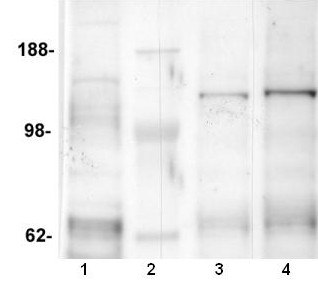产品名称
Anti-Capsaicin Receptor (Ab-1) (824-838) Rabbit pAb, liquid, Calbiochem®
biological source
rabbit
antibody form
purified antibody
antibody product type
primary antibodies
clone
polyclonal
form
liquid
contains
≤0.1% sodium azide as preservative
species reactivity
rat, mouse
manufacturer/tradename
Calbiochem®
storage condition
OK to freeze
avoid repeated freeze/thaw cycles
isotype
IgG
shipped in
wet ice
storage temp.
−20°C
target post-translational modification
unmodified
Quality Level
Gene Information
mouse ... Trpv1(193034)
Analysis Note
Positive Control
Mouse spinal cord dorsal horn
Mouse spinal cord dorsal horn
General description
Protein A purified rabbit polyclonal antibody. Recognizes the ~100 kDa capsaicin receptor protein.
Recognizes the ~100 kDa capsaicin receptor protein in mouse spinal cord extract.
Anti-Capsaicin Receptor (Ab-1) (824-838), rabbit polyclonal, recognizes the ~100 kDa capsaicin receptor in mouse spinal cord extract. It is validated for WB, IF & IHC in frozen and paraffin sections.
Application


Frozen Sections (5 g/ml, see application references)
Immunoblotting (5-10 g/ml)
Immunofluorescence (2 g/ml)
Paraffin Sections (5 g/ml; no pre-treatment required)
Disclaimer
Toxicity: Standard Handling (A)
Immunogen
a synthetic peptide (EDAEVFKDSMVPGEK) corresponding to amino acids 824-838 of rat capsaicin receptor, conjugated to KLH
Other Notes
Caterina, M.J., et al. 1999. Nature398, 436.
Gau, A., et al. 1999. Eur. J. Neurosci.11, 946.
Michael, G.J., and Priestley, J.V. 1999. J. Neurosci.19, 1844.
Caterina, M.J., et al. 1997. Nature389, 816.
Szallasi, A. 1994. Gen. Pharmacol.25, 223.
Beven, S., and Szolcsanyi, J. 1990. Trends Pharmacol. Sci.11, 330.
Fields, H.L. 1987. Pain (New York: McGraw-Hill).
Gau, A., et al. 1999. Eur. J. Neurosci.11, 946.
Michael, G.J., and Priestley, J.V. 1999. J. Neurosci.19, 1844.
Caterina, M.J., et al. 1997. Nature389, 816.
Szallasi, A. 1994. Gen. Pharmacol.25, 223.
Beven, S., and Szolcsanyi, J. 1990. Trends Pharmacol. Sci.11, 330.
Fields, H.L. 1987. Pain (New York: McGraw-Hill).
Immunohistochemistry was performed on mouse spinal cord sections fixed in 4% paraformaldehyde. Immunohistochemical staining results correlate well with other independent reports and in situ hybridization studies. Antibody should be titrated for optimal results in individual systems.
Packaging
Please refer to vial label for lot-specific concentration.
Legal Information
CALBIOCHEM is a registered trademark of Merck KGaA, Darmstadt, Germany
未找到合适的产品?
试试我们的产品选型工具.
存储类别
12 - Non Combustible Liquids
wgk
nwg
flash_point_f
Not applicable
flash_point_c
Not applicable
N J Spencer et al.
Neuroscience, 153(2), 518-534 (2008-04-09)
Rodents detect visceral pain in response to noxious levels of rectal distension. However, the mechanoreceptors that innervate the rectum and respond to noxious levels of rectal distension have not been identified. Here, we have identified the mechanoreceptors of capsaicin-sensitive rectal
Klaus Bielefeldt et al.
American journal of physiology. Gastrointestinal and liver physiology, 291(5), G987-G997 (2006-05-27)
Recent studies suggest that the capsaicin receptor [transient receptor potential vanilloid (TRPV)1] may play a role in visceral mechanosensation. To address the potential role of TRPV1 in vagal sensory neurons, we developed a new in vitro technique allowing us to
Nathaniel A Jeske et al.
Pain, 146(3), 301-307 (2009-09-22)
Post-translational modifications on various receptor proteins have significant effects on receptor activation. For the Transient Receptor Potential family V type 1 (TRPV1) receptor, phosphorylation of certain serine/threonine amino acid residues sensitizes the receptor to activation by capsaicin and heat. Although
Kenneth E Fasanella et al.
The Journal of comparative neurology, 509(1), 42-52 (2008-04-18)
Dysfunction of primary afferents innervating the pancreas has been shown to contribute to the development of painful symptoms during acute and chronic pancreatitis. To investigate the distribution and neurochemical phenotype of pancreatic afferents, Alexa Fluor-conjugated cholera toxin B (CTB) was
J L Saloman et al.
Neuroscience, 232, 226-238 (2012-12-04)
Musculoskeletal pain conditions, particularly those associated with temporomandibular disorders (TMD) affect a large percentage of the population. Identifying mechanisms underlying hyperalgesia could contribute to the development of new treatment strategies for the management of TMD and other muscle pain conditions.
我们的科学家团队拥有各种研究领域经验,包括生命科学、材料科学、化学合成、色谱、分析及许多其他领域.
联系客户支持